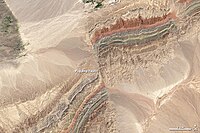
Photo from wikipedia
ABSTRACT Using seismic attributes such as coherence and curvature to characterise faults not only can improve the efficiency of seismic interpretation but also can expand the capability to detect faults.… Click to show full abstract
ABSTRACT Using seismic attributes such as coherence and curvature to characterise faults not only can improve the efficiency of seismic interpretation but also can expand the capability to detect faults. The coherence and curvature have been widely applied to characterising faults for years. These two methods detect faults based on the similarity of seismic waveforms and shapes of the reflectors, respectively, and they are complementary to each other and both have advantages and disadvantages in fault characterisation. A recent development in fault characterisation based on reflector shapes has been the use of the rate of change of curvature. Through an application to the seismic data from Western Tazhong of the Tarim Basin, China, it was demonstrated that the rate of change of curvature is more capable of detecting subtle faults having quite small throws and heaves. However, there often exist multiple extreme values indicating the same fault when applying the rate of change of curvature, which significantly degrades the signal‐to‐noise ratio of the computation result for multiple extrema interfering with each other. To resolve this problem, we propose the use of a linear combination of arctangent and proportional functions as the directrix of a cylindrical surface to fit the fault model and calculate its third derivative, which can then be used to characterise the fault. Through an application to the 3D seismic data from Western Tazhong of the Tarim Basin, the results show that the proposed method not only retains the same capability to detect subtle faults having small throws as the curvature change rate but also greatly improves the signal‐to‐noise ratio of the calculated result.
Journal Title: Geophysical Prospecting
Year Published: 2017
Link to full text (if available)
Share on Social Media: Sign Up to like & get
recommendations!